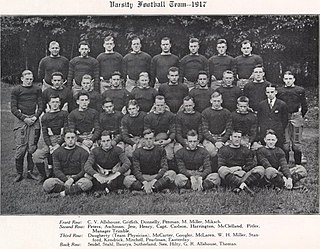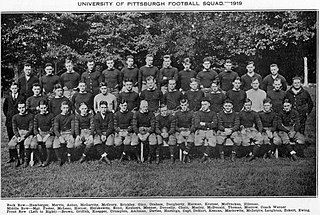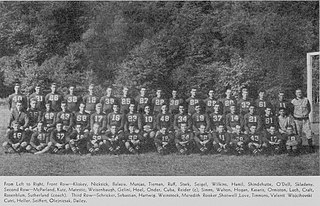Related Research Articles

Glenn Scobey Warner, most commonly known as Pop Warner, was an American college football coach at various institutions who is responsible for several key aspects of the modern game. Included among his innovations are the single and double wing formations, the three point stance and the body blocking technique. Fellow pioneer coach Amos Alonzo Stagg called Warner "one of the excellent creators". He was inducted as a coach into the College Football Hall of Fame as part of its inaugural class in 1951. He also contributed to a junior football program which became known as Pop Warner Little Scholars, a popular youth American football organization.

Wilbur Francis "Pete" Henry was an American football player, coach, and athletic administrator. He was a charter inductee into both the College Football Hall of Fame in 1951 and the Pro Football Hall of Fame in 1963.

The Youngstown Patricians were a semi-professional football team based in Youngstown, Ohio. In the 1910s, the team briefly held the professional football championship and established itself as a fierce rival of more experienced clubs around the country, some of which later formed the core of the National Football League. The Patricians football team motto was "With Malice to None and a Square Deal to all."
Harry Duplein Robb was an American football player and coach during the 1920s.
The Cleveland Panthers were a professional American football team. They were an independent team founded in 1919 from the remains of the Youngstown Patricians. The Panthers played, with various degrees of success, continuously from 1919 and eventually, as fewer opponents played them each year after 1926, sputtered to a quiet folding in 1933.
The Massillon Tigers were an early professional football team from Massillon, Ohio. Playing in the "Ohio League", the team was a rival to the pre-National Football League version of the Canton Bulldogs. The Tigers won Ohio League championships in 1903, 1904, 1905, and 1906, then merged to become "All-Massillons" to win another title in 1907. The team returned as the Tigers in 1915 but, with the reemergence of the Bulldogs, only won one more Ohio League title. Pro football was popularized in Ohio when the amateur Massillon Tigers hired four Pittsburgh pros to play in the season-ending game against Akron. At the same time, pro football declined in the Pittsburgh area, and the emphasis on the pro game moved west from Pennsylvania to Ohio.
The 1920 Buffalo All-Americans season was the franchise's inaugural season with the American Professional Football Association (APFA), an American football league, and fifth total as a team. The All-Americans entered 1920 coming off a 9–1–1 record in 1919 as the Buffalo Prospects in the New York Pro Football League (NYPFL). Several representatives from another professional football league, the Ohio League, wanted to form a new national league, and thus the APFA was created.

The 1920 Canton Bulldogs season was the franchise's sixteenth and its first in the American Professional Football Association (APFA), which became the National Football League two years later. Jim Thorpe, the APFA's president, was Canton's coach and a back who played on the team. The Bulldogs entered the season coming off a 9–0–1 performance as Ohio League champions in 1919. The team opened the season with a 48–0 victory over the Pitcairn Quakers, and finished with a 7–4–2 record, taking eighth place in the 14-team APFA. A then-record crowd of 17,000 fans watched Canton's week 12 game against Union AA of Phoenixville.
The Fort Wayne Friars were an early professional football team based in Fort Wayne, Indiana. The team, which was also known as the Friars Athletic Association, consistently fielded good and noteworthy teams. Because Fort Wayne is situated near the Ohio border, the Friars often played Ohio teams as well as those from Indiana.
The McKeesport Olympics were a professional football team from McKeesport, Pennsylvania from 1896 until around 1940. The Olympics were considered one of the top football teams in Pennsylvania from 1910 until 1919.
American football in Western Pennsylvania, featuring the city of Pittsburgh and surrounding areas, has had a long and storied history, dating back to the early days of the sport. All levels of football, including high school football and college football, are followed passionately, and the area's National Football League (NFL) team, the Pittsburgh Steelers, is consistently one of the sport's most popular teams. Many of the NFL's top stars have come from the region as well, especially those that play quarterback, earning Western Pennsylvania the nickname "Cradle of Quarterbacks".
The Western Pennsylvania Professional Football Circuit was a loose association of American football clubs that operated from 1890 to approximately 1940. Originally amateur, professionalism was introduced to the circuit in 1892; cost pressures pushed the circuit to semi-professional status from about 1920 through the rest of its existence. Existing in some form for 48 years, it was one of the longest-lived paying football loops to operate outside the auspices of the National Football League.

The 1918 Pittsburgh Panthers football team represented the University of Pittsburgh in the 1918 college football season. In a season cut short by the Spanish flu pandemic, coach Pop Warner led the Panthers in a schedule played all in one month, including a convincing victory in a highly publicized game over defending national champion and unscored-upon Georgia Tech. A highly controversial loss ended the season and snapped a 32-game Pitt winning streak, but the Panthers outscored opponents 140–16 in that short season and were retroactively selected as the national champion by the Helms Athletic Foundation and Houlgate System and as a co-national champion with Michigan by the National Championship Foundation.

The 1917 Pittsburgh Panthers football team represented the University of Pittsburgh in the 1917 college football season. Led by coach Pop Warner, the Panthers won all ten games and outscored their opponents by a combined total of 260–31.
The Canton Bulldogs were a professional American football team, based in Canton, Ohio. They played in the Ohio League from 1903 to 1906 and 1911 to 1919, and the American Professional Football Association, from 1920 to 1923, and again from 1925 to 1926. The Bulldogs won the 1916, 1917, and 1919 Ohio League championships. They were the NFL champions in 1922 and 1923. In 1921–1923, the Bulldogs played 25 straight games without a defeat. This remains an NFL record.

The 1920 Pittsburgh Panthers football team was an American football team that represented the University of Pittsburgh as an independent during the 1920 college football season. In its sixth season under head coach Pop Warner, the team compiled a 6–0–2 record and outscored all opponents by a total of 146 to 44. The team played its home games at Forbes Field in Pittsburgh. “Perhaps due to the resurrection of sports after the war period, Pitt enjoyed an athletic year that was quite indicative of its pre-war strength, which so practically dominated college sport activities in this section for many years. The season of 1920-21 boasted of representative Pitt teams in every branch of sport - football, basketball, baseball, track, swimming and tennis. Aviation, which made its initial bow at the University last year, progressed in fine manner – the team having been entered in the big intercollegiate meet.″

The 1919 Pittsburgh Panthers football team was an American football team that represented the University of Pittsburgh as an independent during the 1919 college football season. In its fifth season under head coach Pop Warner, the team compiled a 6–2–1 record and outscored all opponents by a total of 119 to 66. The team played its home games at Forbes Field in Pittsburgh.

The 1921 Pittsburgh Panthers football team was an American football team that represented the University of Pittsburgh as an independent during the 1921 college football season. In its seventh season under head coach Pop Warner, the team compiled a 5–3–1 record and outscored all opponents by a total of 133 to 50. The team played its home games at Forbes Field in Pittsburgh.

The 1932 Pittsburgh Panthers football team was an American football team that represented the University of Pittsburgh as an independent during the 1932 college football season. In its ninth season under head coach Jock Sutherland, the team compiled an 8–1–2 record, shut out eight of its eleven opponents, suffered its sole loss to USC in the 1933 Rose Bowl, and outscored all opponents by a total of 182 to 60. The team played its home games at Pitt Stadium in Pittsburgh.
The Toronto Tigers were a semi-professional American football team that played from 1962 to 1964. The team was based in Toronto, Ohio, and played in the Midwest Football League in 1964. They were coached by Clarke Hinkle in 1962 and Jack Stutz from 1963 to 1964.
References
- Johnson, Pearce (1987). "When Did They Start?" (PDF). Coffin Corner. Professional Football Researchers Association. 9 (6): 1–5. Archived from the original (PDF) on 2010-11-27.
- Pre-NFL Committee (2005). "Pitcairn Quakers" (PDF). Professional Football Researchers Association. pp. 1–3.
- Dugo, Andy (3 June 1969). "Pitcairn's Grid Quakers". Pittsburgh Post-Gazette. Vol. 42, no. 263 (Final City ed.). p. 27.
- "Pitcairn Quakers Beat McKeesport Olympics". The Gazette Times. Vol. 134, no. 118. Pittsburgh. 23 November 1919. sec. 3, p. 4.